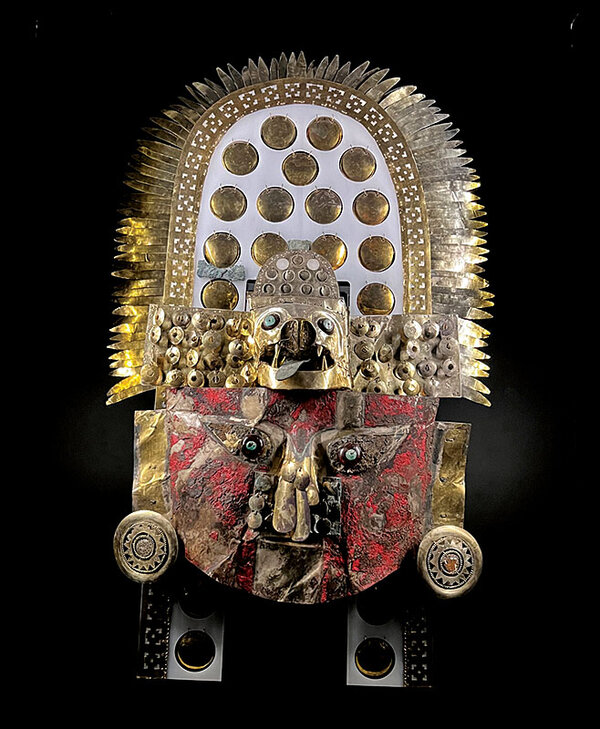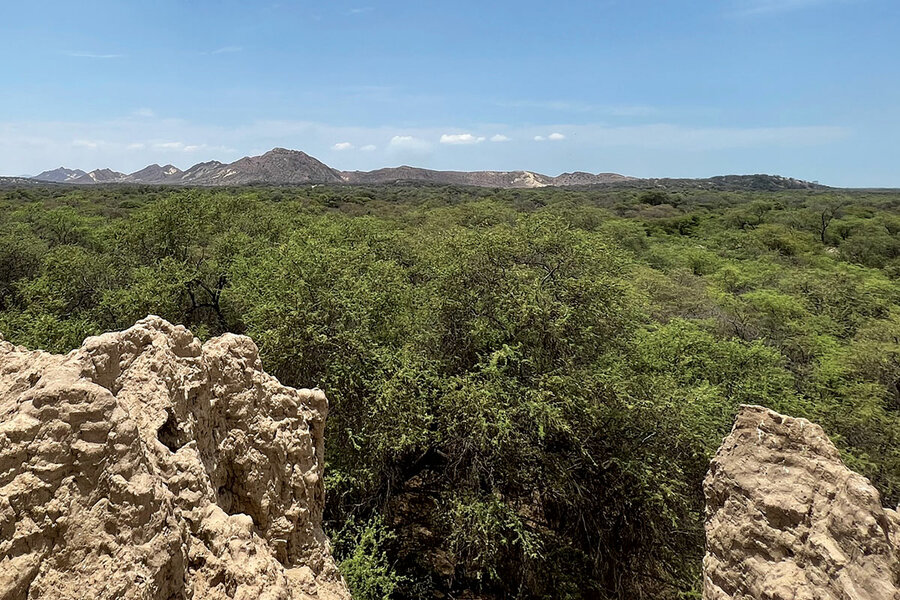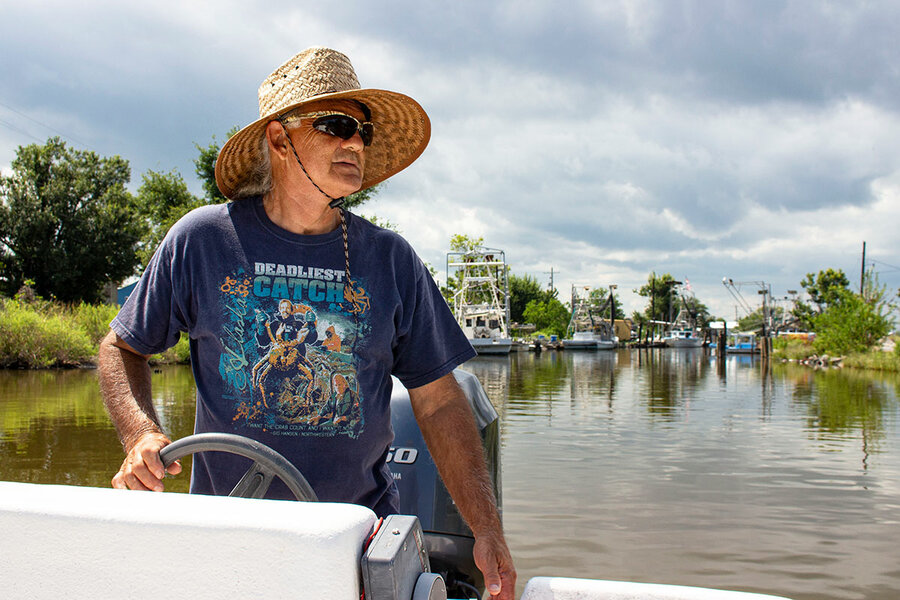Original publication by Howard LaFranchi for csmonitor.com on 10 May 2023

Park ranger Carlos Alberto Llauce Baldera points out one of the dozens of Sicán adobe pyramids that dot the Pómac Forest Historical Sanctuary.
Carlos Alberto Llauce Baldera holds the green seedpod of a young algarrobo tree as if displaying a piece of fine jewelry.
“These seedpods tell us the reforestation of this damaged area is a success,” says the seasoned park ranger at the Pómac Forest Historical Sanctuary in northern Peru’s Lambayeque region.
Not long ago this kind of discovery felt out of reach. For nearly eight years and ending with a violent eviction in 2009, hundreds of families were squatting illegally here on large swaths of the roughly 23-square-mile reserve.
According to locals, the park wasn’t well protected at the time, and families from distant Peruvian provinces arrived, lured by unscrupulous land speculators with promises of available parkland to purchase and settle. Their presence meant a trampling of the forest, where the squatters clear-cut virgin equatorial trees, dug dozens of wells, built homes, and planted crops.
Gesturing to a nearby, white-washed chapel sheltering the simple graves of two national police officers killed during the court-ordered evictions, Mr. Llauce adds, “Thanks to them our beautiful forest is coming back.”
While Mr. Llauce credits others, he is an unsung hero of the Pómac Forest, a dense tangle of algarrobo and mesquite that shelters more than 100 species of birds and numerous small mammals. This dry forest was once home to the pre-Inca Sicán culture, whose adobe pyramids still dot the landscape.

Artifacts uncovered in this territory are on display at the Sicán National Museum.
Nearly 15 years after helping guide police through the unfamiliar, dense forest terrain, Mr. Llauce remains dedicated to the patient rehabilitation and reforestation work that has resulted in a healthy reserve, alive with a cacophony of birds – and thriving algarrobos.
“We’ve all come together to return lands that were so damaged to their beautiful natural state,” Mr. Llauce says, referring to the surrounding communities and fellow guides, as he walks along a trail through thickets as impenetrable as a mangrove forest.
“Gives us life”
What initially started as a way for Mr. Llauce to take home a regular paycheck soon became employment with a purpose. He says he learned early on in his career, which began in 2000, that successfully protecting and preserving the Pómac Forest could never work if it remained important only to the reserve’s seven park guards – or to one-time visitors and the occasional biologist or archaeologist.
These days Mr. Llauce takes home stories of the work he’s doing – the birds that are thriving and the happy moments when he spots a favorite, like the Peruvian plantcutter and the huerequeque – to his two young sons. One of them, he notes proudly, says he wants to become a park guard one day, too.
“When I started here we had two big problems: the illegal cutting of wood, and chronic land invasions and illegal claim-staking,” he says.
“Back then the people who lived on the periphery of the park were a big part of those problems,” he adds. “But with a lot of community work to educate the neighbors, we can now say they are our partners. There’s a lot more understanding of the value of the park; we now work together to preserve its riches.”
In recent years, Mr. Llauce and his Pómac ranger colleagues have spent a lot of time in the small settlements around the park to develop what is now a network of more than 280 volunteers – many of whom take part in park patrols.
At the tiny settlement of Ojo de Toro Alto that sits just outside a park gate, Mr. Llauce stops at the home of Mauricio Villegas Cadenillas, a farmer who has served as a community volunteer since 2009.
The park ranger’s arrival sets off a whirl of activity: Mr. Villegas creates a circle of chairs for his visitors while his wife fetches a bottle of citrus water and a bowl of garden-grown mangoes.
“The park guards are very important parts of our lives here now. They are like brothers,” says Mr. Villegas, who takes a seat next to Mr. Llauce.

The Pómac is a dry forest (as opposed to a rainforest) that shelters more than 100 species of birds and numerous small mammals.
Mr. Villegas recalls that when he arrived with his family in 1994, “the forest was a marvel” for them. But gradually illegal woodcutting inside the park accelerated, sometimes carried out by neighbors, and then the squatters arrived.
By the time the squatters were evicted, he says, most of the park’s neighboring families were ready to take the counsel of park rangers like Mr. Llauce more seriously. “We talked a lot about protecting the woods, and most people around here have embraced that,” he says. “People understand that the forest purifies our air, and so it gives us life.”
In exchange for helping to protect the park, neighbors are allowed to undertake some activities in limited areas inside, including beekeeping, fruit-growing, animal grazing, and gathering algarrobo seed pods, says Mr. Llauce. When crushed, the seeds provide an energizing diet supplement that locals trace back to the laborers who built the Sicán pyramids.
“Critical” role
Mr. Llauce is one of 761 park guards across Peru whose job it is to protect and preserve the country’s natural riches for future generations. Indeed Peru, with its rainforests, high-mountain ecosystems, scorched deserts, long Pacific coastline, and unique environments like this dry forest, ranks among the world’s most biodiverse countries.
With the world’s ecosystems facing intense pressures, safeguarding that rich biodiversity has become increasingly important globally.
“This job is really about conservation of our country’s natural riches,” Mr. Llauce says – pausing when he hears the muffled buzz of a chainsaw somewhere across the park valley. He makes a note to check later for illegal woodcutting.
“It’s a risky job, not well paid, but one that is critical,” says Pablo Venegas, curator of amphibians and reptiles at Lima’s Center for Ornithology and Biodiversity.

A chapel honors two police officers killed during the 2009 eviction of squatters from parklands.
He calls guards like Mr. Llauce “brave,” noting they are “out there confronting the illegal woodcutters, miners, and hunters, and the drug traffickers who use the parks to grow their products like coca or to transport them – and those bad actors are very often armed while the park guards are not.”
And he credits park guards with helping him in his professional pursuits, too. Over the past 16 years of scientific expeditions across Peru, Mr. Venegas has discovered dozens of new frog and lizard species.
“How many times have I shown guards a picture of the type of lizard I suspect is around there, and they’ll say, ‘yes we’ve seen that around this streambed or that part of the woods,’ and they’ll be right,” he says.
Pómac may not have the draw that Machu Picchu does, but Mr. Llauce says tourists and researchers still eagerly arrive, and are key to the local economy.
Surveying the park from a hillside overlook, Mr. Llauce points out numerous adobe pyramids poking out above the forest. These date back a millennium to the Sicán people.
“Those pyramids and the treasures many of them surely hold inside are our heritage, just as this beautiful forest is our heritage,” he says.
“This reserve will go on giving us all so much, if we preserve and protect it.”




